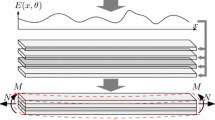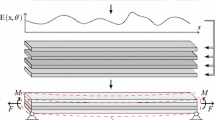Summary
The load-duration behavior of wood floor joists was examined using the Monte Carlo method. The simulations were performed using a cumulative damage model and a stochastic floor live load model. Floor joists designed to the existing American wood design code exhibited a decreasing failure rate. Although weak members tended to be the ones to fail, a majority of the weak members in a population were still surviving after 50 years. The total number of joists to fail in 50 years is very dependent on the distributional assumption made for short term strength.
Similar content being viewed by others
References
American National Standards Institute 1982: American national standard minimum design loads for buildings and other structures. ANSI A58.1-1982. ANSI, New York, NY
Barlow, R. E.: Proschan, F. 1975: Statistical theory of reliability and life testing, pp. 27–28. New York: Holt, Rinehart and Winston
Barrett, J. D.; Foschi, R. O. 1978: Duration of load and probability of failure in wood. Part I: Modelling creep rupture. Canadian J. of Civil Engrg. 5: 505–514
Barrett, J. D.; Foschi, R. O. 1978: Duration of load and probability of failure in wood. Part II: Constant, ramp and cyclic loadings. Canadian J. of Civil Engrg. 5: 515–532
Bratley, P.; Fox, B. L.; Schrage, L. E. 1983: A guide to simulation. Berlin Heidelberg New York Tokyo: Springer
Corotis, R. B.; Tsay, W.-Y. 1983: Probabilistic load duration model for live loads. J. of Struct. Engrg., ASCE, 109: 859–874
Foschi, R. O.; Barrett, J. D. 1982: Load-duration effects in western hemlock lumber. J. of the Struct. Div., ASCE, 108 (ST7): 1494–1510
Gerhards, C. C. 1977: Effect of duration and rate of loading on strength of wood and wood-based materials. Madison: USDA Forest Services Research Report FPL 283
Gerhards, C. C. 1979: Time related effects of loading on wood strength: A cumulative damage theory. Wood Sci. 11: 139–144
Gerhards, C. C.; Link, C. L. 1983: A cumulative damage model for lumber. In: Proceedings of the fourth Engrg. Mech. Div. Specialty Conf., pp. 940–943. New York: ASCE
Haupt, H. 1867: General theory of bridge construction, pp. 60–62. New York: D. Appleton
Madsen, B. 1978: Time-strength relationship for lumber. In: Proceedings of the first Int. Conf. on Wood Fract., pp. 111–127. Vancouver, B.C.
Nakai, T.; Grossman, P. U. A. 1983: Deflection of wood under intermittent loading — Part I: Fortnightly cycles. Wood Sci. Technol. 17: 55–67
National Forest Products Association, 1982: National design specification for wood construction. Washington, D.C.:NFPA
Nelson, W. 1982: Applied life data analysis. New York: John Wiley and Sons
Spencer, R. 1978: Rate of load effect in bending for Douglas-fir lumber. In: Proceedings of the first Int. Conf. on Wood Fract., pp. 259–265. Vancouver, B.C.
Strickler, M. D.; Pellerin, R. F.; Martin, J. W. 1976: Duration of load characteristics of structural members in bending and tension. Bulletin 340. Pullman: Washington State University
Wood, W. L. 1951: Relation of strength of wood to duration of loads. Madison: USDA Forest Service Report No. 1916
Author information
Authors and Affiliations
Rights and permissions
About this article
Cite this article
Bulleit, W.M., Schoch, C.G. Simulation of load-duration effects in wood. Wood Sci. Technol. 20, 157–167 (1986). https://doi.org/10.1007/BF00351027
Received:
Issue Date:
DOI: https://doi.org/10.1007/BF00351027




